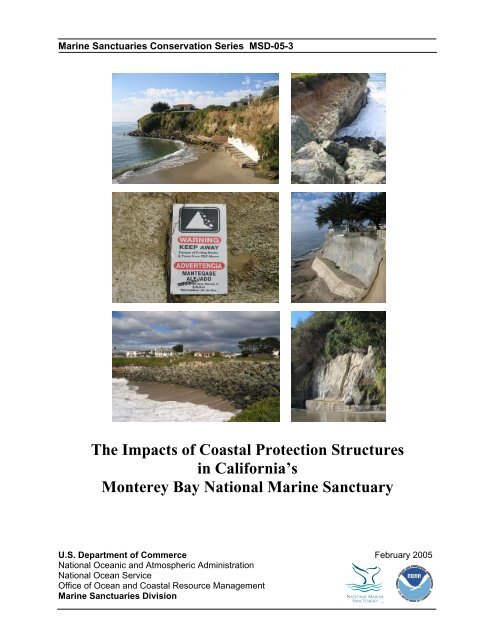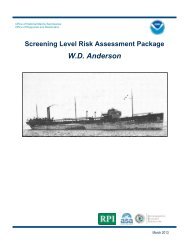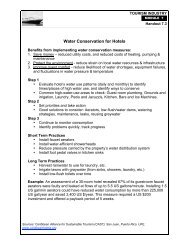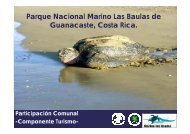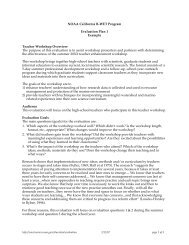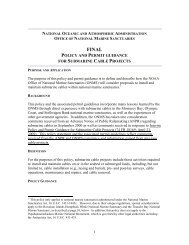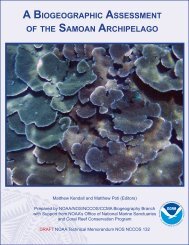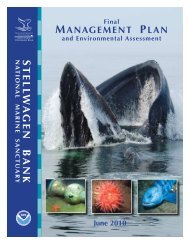The Impacts of Coastal Protection Structures in California's Monterey ...
The Impacts of Coastal Protection Structures in California's Monterey ...
The Impacts of Coastal Protection Structures in California's Monterey ...
- No tags were found...
Create successful ePaper yourself
Turn your PDF publications into a flip-book with our unique Google optimized e-Paper software.
Mar<strong>in</strong>e Sanctuaries Conservation Series MSD-05-3<strong>The</strong> <strong>Impacts</strong> <strong>of</strong> <strong>Coastal</strong> <strong>Protection</strong> <strong>Structures</strong><strong>in</strong> California’s<strong>Monterey</strong> Bay National Mar<strong>in</strong>e SanctuaryU.S. Department <strong>of</strong> Commerce February 2005National Oceanic and Atmospheric Adm<strong>in</strong>istrationNational Ocean ServiceOffice <strong>of</strong> Ocean and <strong>Coastal</strong> Resource ManagementMar<strong>in</strong>e Sanctuaries Division
About the Mar<strong>in</strong>e Sanctuaries Conservation Series<strong>The</strong> National Oceanic and Atmospheric Adm<strong>in</strong>istration’s Mar<strong>in</strong>e Sanctuary Division (MSD)adm<strong>in</strong>isters the National Mar<strong>in</strong>e Sanctuary Program. Its mission is to identify, designate,protect and manage the ecological, recreational, research, educational, historical, and aestheticresources and qualities <strong>of</strong> nationally significant coastal and mar<strong>in</strong>e areas. <strong>The</strong> exist<strong>in</strong>g mar<strong>in</strong>esanctuaries differ widely <strong>in</strong> their natural and historical resources and <strong>in</strong>clude nearshore andopen ocean areas rang<strong>in</strong>g <strong>in</strong> size from less than one to over 5,000 square miles. Protectedhabitats <strong>in</strong>clude rocky coasts, kelp forests, coral reefs, sea grass beds, estuar<strong>in</strong>e habitats, hardand s<strong>of</strong>t bottom habitats, segments <strong>of</strong> whale migration routes, and shipwrecks.Because <strong>of</strong> considerable differences <strong>in</strong> sett<strong>in</strong>gs, resources, and threats, each mar<strong>in</strong>e sanctuaryhas a tailored management plan. Conservation, education, research, monitor<strong>in</strong>g andenforcement programs vary accord<strong>in</strong>gly. <strong>The</strong> <strong>in</strong>tegration <strong>of</strong> these programs is fundamental tomar<strong>in</strong>e protected area management. <strong>The</strong> Mar<strong>in</strong>e Sanctuaries Conservation Series reflects andsupports this <strong>in</strong>tegration by provid<strong>in</strong>g a forum for publication and discussion <strong>of</strong> the complexissues currently fac<strong>in</strong>g the National Mar<strong>in</strong>e Sanctuary Program. Topics <strong>of</strong> published reportsvary substantially and may <strong>in</strong>clude descriptions <strong>of</strong> educational programs, discussions onresource management issues, and results <strong>of</strong> scientific research and monitor<strong>in</strong>g projects. <strong>The</strong>series facilitates <strong>in</strong>tegration <strong>of</strong> natural sciences, socioeconomic and cultural sciences,education, and policy development to accomplish the diverse needs <strong>of</strong> NOAA’s resourceprotection mandate.
<strong>The</strong> <strong>Impacts</strong> <strong>of</strong> <strong>Coastal</strong> <strong>Protection</strong> <strong>Structures</strong> <strong>in</strong> California’s<strong>Monterey</strong> Bay National Mar<strong>in</strong>e SanctuaryRebecca Stamski<strong>Monterey</strong> Bay National Mar<strong>in</strong>e Sanctuary<strong>Monterey</strong>, CAU.S. Department <strong>of</strong> CommerceCarlos M. Gutierrez, SecretaryNational Oceanic and Atmospheric Adm<strong>in</strong>istrationVADM Conrad C. Lautenbacher, Jr. (USN-ret.)Under Secretary <strong>of</strong> Commerce for Oceans and AtmosphereNational Ocean ServiceRichard W. Sp<strong>in</strong>rad, Ph.D., Assistant Adm<strong>in</strong>istratorSilver Spr<strong>in</strong>g, MarylandFebruary 2005Mar<strong>in</strong>e Sanctuaries DivisionDaniel J. Basta, Director
DISCLAIMERReport content does not necessarily reflect the views and policies <strong>of</strong> the National Mar<strong>in</strong>eSanctuary Program or the National Oceanic and Atmospheric Adm<strong>in</strong>istration, nor does themention <strong>of</strong> trade names or commercial products constitute endorsement or recommendation foruse.REPORT AVAILABILITYElectronic copies <strong>of</strong> this report may be downloaded from the National Mar<strong>in</strong>e SanctuariesProgram web site at www.sanctuaries.nos.noaa.gov. Hard copies may be available from thefollow<strong>in</strong>g address:National Oceanic and Atmospheric Adm<strong>in</strong>istrationMar<strong>in</strong>e Sanctuaries DivisionSSMC4, N/ORM621305 East-West HighwaySilver Spr<strong>in</strong>g, MD 20910COVERUpper Left: <strong>Coastal</strong> armor<strong>in</strong>g <strong>in</strong> Capitola, CA. MBNMSCenter Left: Erosion warn<strong>in</strong>g sign, Santa Cruz, CA. MBNMSLower Left: Riprap along Westcliff Drive, Santa Cruz, CA. MBNMSUpper Right: Riprap along Westcliff Drive, Santa Cruz, CA. MBNMSCenter Right: Seawall <strong>in</strong> Capitola, CA. MBNMSLower Right: Seawall <strong>in</strong> Santa Cruz, CA. MBNMSSUGGESTED CITATIONStamski, Rebecca. 2005. <strong>The</strong> impacts <strong>of</strong> coastal protection structures <strong>in</strong> California’s <strong>Monterey</strong>Bay National Mar<strong>in</strong>e Sanctuary. Mar<strong>in</strong>e Sanctuaries Conservation Series MSD-05-3. U.S.Department <strong>of</strong> Commerce, National Oceanic and Atmospheric Adm<strong>in</strong>istration, Mar<strong>in</strong>eSanctuaries Division, Silver Spr<strong>in</strong>g, MD. 18 pp.Rebecca StamskiCalifornia Sea Grant Fellow<strong>Monterey</strong> Bay National Mar<strong>in</strong>e Sanctuary299 Foam Street<strong>Monterey</strong>, CA 93940(831) 647-4228Becky.Stamski@noaa.govCONTACT
ABSTRACTThis report outl<strong>in</strong>es the potential impacts <strong>of</strong> coastal protection structures on the resources <strong>of</strong>the <strong>Monterey</strong> Bay National Mar<strong>in</strong>e Sanctuary. At least 15 miles <strong>of</strong> the Sanctuary’s 300-mileshorel<strong>in</strong>e are currently armored with seawalls and riprap revetments. Most <strong>of</strong> these coastalprotection structures are placed above the mean high tide l<strong>in</strong>e, the <strong>of</strong>ficial boundary <strong>of</strong> theSanctuary, yet some <strong>in</strong>fluences <strong>of</strong> armor<strong>in</strong>g imp<strong>in</strong>ge on the mar<strong>in</strong>e realm and on recreational use.In addition, cont<strong>in</strong>ued sea level rise and accompany<strong>in</strong>g coastal retreat will force many <strong>of</strong> thesestructures below the high tide l<strong>in</strong>e over time. <strong>The</strong> <strong>Monterey</strong> Bay National Mar<strong>in</strong>e Sanctuarystaff has recognized the significance <strong>of</strong> coastal armor<strong>in</strong>g, identify<strong>in</strong>g it as a critical issue <strong>in</strong> the<strong>Coastal</strong> Armor<strong>in</strong>g Action Plan <strong>of</strong> the draft Jo<strong>in</strong>t Management Plan.This summary is <strong>in</strong>tended to provide general background <strong>in</strong>formation for Sanctuary policieson coastal armor<strong>in</strong>g. <strong>The</strong> impacts discussed <strong>in</strong>clude: aesthetic depreciation, beach loss due toplacement, access restriction, loss <strong>of</strong> sand supply from erod<strong>in</strong>g cliffs, passive erosion, and activeerosion. In addition, the potential biological impacts are explored. F<strong>in</strong>ally, an appraisal <strong>of</strong> howdiffer<strong>in</strong>g armor types compare <strong>in</strong> relation to impacts, expense and eng<strong>in</strong>eer<strong>in</strong>g is presented.While the literature cited <strong>in</strong> this report focus predom<strong>in</strong>antly on the California coast, theframework for this discussion could have implications for other actively erod<strong>in</strong>g coastl<strong>in</strong>es.KEY WORDS<strong>Coastal</strong> erosion, armor<strong>in</strong>g, coastal protection structures, seawall, riprap revetment, geology,sanctuary, California, <strong>Monterey</strong> Bayi
TABLE OF CONTENTSTopicAbstract...................................................................................................................Table <strong>of</strong> Contents....................................................................................................List <strong>of</strong> Figures.........................................................................................................PageiiiiiiIntroduction............................................................................................................. 1<strong>Impacts</strong> <strong>of</strong> <strong>Coastal</strong> Armor<strong>in</strong>g <strong>Structures</strong>................................................................. 4Visual <strong>Impacts</strong> ................................................................................................... 4Placement Loss .................................................................................................. 6Access Issues ..................................................................................................... 7Reduction <strong>of</strong> Sand Supply from Armor<strong>in</strong>g <strong>of</strong> Cliffs ......................................... 8Passive Erosion .................................................................................................. 9Active Erosion ................................................................................................... 10Biological <strong>Impacts</strong> ............................................................................................. 11Eng<strong>in</strong>eer<strong>in</strong>g <strong>of</strong> <strong>Coastal</strong> Armor<strong>in</strong>g <strong>Structures</strong>.......................................................... 13Riprap................................................................................................................. 13Seawalls ............................................................................................................. 14Conclusions............................................................................................................. 15Literature Cited ....................................................................................................... 16Acknowledgements................................................................................................. 18ii
LIST OF FIGURESFigure Number and TitlePageFigure 1a: Oblique aerial photographs <strong>of</strong> Stillwell Hall <strong>in</strong> 2002............................ 1Figure 1b: Oblique aerial photographs <strong>of</strong> former Stillwell Hall site <strong>in</strong> 2004 ......... 2Figure 2: Concrete blocks used as riprap................................................................ 4Figure 3: An unplanned assemblage <strong>of</strong> coastal armor<strong>in</strong>g....................................... 5Figure 4: Cliff stabilization built to fill a seacave................................................... 6Figure 5: Riprap cover<strong>in</strong>g up significant amount <strong>of</strong> beach area............................. 7Figure 6: Recent bluff stabilization project ............................................................ 8Figure 7: Aerial-perspective, schematic diagram depict<strong>in</strong>g beach loss over timedue to fix<strong>in</strong>g the coastl<strong>in</strong>e with armor ..................................................... 9Figure 8: Algae grow<strong>in</strong>g on riprap.......................................................................... 12Figure 9: Riprap boulders settled <strong>in</strong>to sand ............................................................ 14iii
INTRODUCTIONEighty-six percent <strong>of</strong> California’s 1,100 miles <strong>of</strong> coastl<strong>in</strong>e is erod<strong>in</strong>g (Griggs 1999), yet nowmore than ever, people want to live at that retreat<strong>in</strong>g boundary between land and sea. Erosion <strong>of</strong>the coast has been occurr<strong>in</strong>g for the past 18,000 years, when the last glacial period ended and sealevel began to rise. <strong>Coastal</strong> cliffs are retreat<strong>in</strong>g at an average rate <strong>of</strong> 10 to 30 centimeters per yearacross the state (Griggs and Patsch 2004a), although erosion rates can be as high as 4.5 metersper year (Griggs and Patsch 2004b). Extreme variability <strong>in</strong> the rates and severity <strong>of</strong> coastalerosion, particularly <strong>in</strong> relation to El Niño storm patterns and local geomorphic conditions,complicates property protection decisions. In addition, the politics <strong>of</strong> public and private landownership <strong>in</strong> the coastal zone make coastal armor<strong>in</strong>g a contentious issue for Californians.Several alternatives have been recognized to deal with the confluence <strong>of</strong> coastal developmentand erod<strong>in</strong>g shorel<strong>in</strong>es, none <strong>of</strong> which are a panacea. In the extreme case, property owners candemolish the build<strong>in</strong>g or relocate it landward, either on the same parcel or on an entirelydifferent <strong>in</strong>land location. Neither <strong>of</strong> these choices is ideal for property owners, though theyshould be considered as serious, long-term solutions to this <strong>in</strong>evitable dilemma, given the ris<strong>in</strong>gcosts <strong>of</strong> other alternatives (Griggs 1986). For example, Stillwell Hall, built <strong>in</strong> the 1940’s as theFort Ord soldier’s club <strong>in</strong> Seaside, California, was torn down <strong>in</strong> March 2004 because the cost <strong>of</strong>both coastal armor<strong>in</strong>g and relocat<strong>in</strong>g were too high (Figures 1a and b).Figure 1a: Oblique aerial photograph <strong>of</strong> Stillwell Hall <strong>in</strong> 2002 <strong>in</strong> Mar<strong>in</strong>a, CA. <strong>Coastal</strong> protection structures placedat the base <strong>of</strong> the aged build<strong>in</strong>g were neither effective nor efficient enough keep up with <strong>in</strong>tense coastal erosion <strong>of</strong>adjacent bluffs. Photograph copyright © 2002 Kenneth & Gabrielle Adelman (http://www.californiacoastl<strong>in</strong>e.org/).1
Figure 1b: Oblique aerial photograph <strong>of</strong> the former Stillwell Hall location after the build<strong>in</strong>g and associated coastalprotection structures were removed <strong>in</strong> March 2004. Photograph copyright © 2002 Kenneth & Gabrielle Adelman(http://www.californiacoastl<strong>in</strong>e.org/).Beach nourishment has been highlighted recently as a solution to coastal erosion; proponents<strong>of</strong> this alternative ma<strong>in</strong>ta<strong>in</strong> that <strong>in</strong>creas<strong>in</strong>g beach width by physically add<strong>in</strong>g sand to a beachbuffers wave energy and slows retreat rates. Federal, state and local government agencies arepursu<strong>in</strong>g this method as a way to protect property from erosion damage, but the costs aregenerally very high and the net, long-term benefits <strong>of</strong> beach nourishment will vary greatlydepend<strong>in</strong>g on local conditions (Leonard et al. 1990).A survey <strong>of</strong> west coast beach nourishment projects determ<strong>in</strong>ed that only 27% survived morethan 5 years and 18% lasted less than 1 year (Leonard et al. 1990). In some cases, sand that wasplaced on a beach dur<strong>in</strong>g summer was completely washed away the follow<strong>in</strong>g w<strong>in</strong>ter. This is notunexpected given the high littoral drift rates that characterize most <strong>of</strong> the coast <strong>of</strong> California. Acost-benefit analysis <strong>of</strong> proposed nourishment projects should <strong>in</strong>clude site-specific evaluations <strong>of</strong>littoral budgets. In addition, the availability <strong>of</strong> an appropriate, cost-effective sand source andpotential <strong>in</strong>terference between beach users and sand transportation equipment should beaddressed. As an alternative, beach width might be <strong>in</strong>creased by remov<strong>in</strong>g dams that impoundsignificant amounts <strong>of</strong> sand <strong>in</strong> coastal streams (Willis and Griggs 2003).By far the most popular option to manage shorel<strong>in</strong>e retreat <strong>in</strong> California has been theconstruction <strong>of</strong> coastal protection structures (also referred to as coastal armor<strong>in</strong>g).Approximately 10% <strong>of</strong> California’s coastl<strong>in</strong>e is currently armored (Griggs <strong>in</strong> press-a). <strong>The</strong>complexity and significance <strong>of</strong> coastal armor<strong>in</strong>g <strong>in</strong> California are evidenced by numerousscientific studies, <strong>in</strong>volvement <strong>of</strong> non-pr<strong>of</strong>it organizations, such as the Sierra Club and theSurfrider Foundation, and media coverage <strong>of</strong> the issue, such as KQED’s <strong>Coastal</strong> Clashdocumentary (http://www.kqed.org/w/coastalclash/home.html). <strong>The</strong> costs <strong>of</strong> armor<strong>in</strong>g can besignificant; millions <strong>of</strong> federal, state and private dollars have been expended annually on shore2
protection, which can cost anywhere from $1800 to $7600 per l<strong>in</strong>ear foot <strong>of</strong> coast (Griggs <strong>in</strong>press-a).Armor<strong>in</strong>g varies widely <strong>in</strong> type <strong>of</strong> material, degree <strong>of</strong> eng<strong>in</strong>eer<strong>in</strong>g, and relative success <strong>in</strong>prevent<strong>in</strong>g coastal erosion and provid<strong>in</strong>g property protection (Griggs and Fulton-Bennett 1988).Riprap and seawalls are the most common armor<strong>in</strong>g structures used <strong>in</strong> central California. Riprapcan be def<strong>in</strong>ed as any large (1 to 6 ton) rocks used for coastal protection, with vary<strong>in</strong>g degrees <strong>of</strong>eng<strong>in</strong>eer<strong>in</strong>g; seawalls are cont<strong>in</strong>uous, rigid structures with vertical or concave faces. To clarify acommon misconception, it is important to note that armor<strong>in</strong>g is emplaced to protect build<strong>in</strong>gsand <strong>in</strong>frastructure, not beaches (Kraus and McDougal 1996). Gro<strong>in</strong> fields and beachnourishment are the common methods by which beaches are expanded, both <strong>of</strong> which arefundamentally different than armor<strong>in</strong>g, which is constructed to halt erosion <strong>of</strong> cliffs, bluffs ordunes that have build<strong>in</strong>gs beh<strong>in</strong>d or on top <strong>of</strong> them, or to protect a build<strong>in</strong>g built on thebackshore (above the high tide l<strong>in</strong>e).Public concern over use and regulation <strong>of</strong> the California coastl<strong>in</strong>e was aired <strong>in</strong> the early1970s, the result <strong>of</strong> which was the establishment <strong>of</strong> the California <strong>Coastal</strong> Act <strong>in</strong> 1976. This actcreated the California <strong>Coastal</strong> Commission (Commission), which is tasked with regulat<strong>in</strong>gdevelopment <strong>in</strong> the coastal zone. Under the <strong>Coastal</strong> Act, new armor is only allowed to protectexist<strong>in</strong>g structures and new build<strong>in</strong>gs must be setback enough to ensure that erosion will notthreaten the house with<strong>in</strong> its projected lifespan. <strong>The</strong> Commission, <strong>in</strong> coord<strong>in</strong>ation with localcoastal plann<strong>in</strong>g agencies, provides permits for the emplacement and ma<strong>in</strong>tenance <strong>of</strong> coastalprotection structures. Unfortunately, ambiguous language with<strong>in</strong> the <strong>Coastal</strong> Act has beenexploited and there is a need to design more specific long-range plans to limit the extent <strong>of</strong>coastal armor<strong>in</strong>g (Griggs et al. 1992).<strong>The</strong> <strong>Monterey</strong> Bay National Mar<strong>in</strong>e Sanctuary (Sanctuary), which encompasses 276 miles(444.2 km) <strong>of</strong> coastl<strong>in</strong>e from Mar<strong>in</strong> to Cambria, was designated <strong>in</strong> 1992 to protect the resources<strong>of</strong> this unique mar<strong>in</strong>e environment. As <strong>of</strong> 1998, 15.1 miles (24.3 km) <strong>of</strong> the Sanctuary’scoastl<strong>in</strong>e have been armored (Griggs et al. <strong>in</strong> press-b). Various physical and biological impacts<strong>of</strong> coastal armor<strong>in</strong>g may affect the resources <strong>of</strong> the Sanctuary both directly and <strong>in</strong>directly. Mostcoastal protection structures are placed above the high tide l<strong>in</strong>e, the <strong>of</strong>ficial boundary <strong>of</strong> theSanctuary; yet some <strong>in</strong>fluences <strong>of</strong> armor<strong>in</strong>g may imp<strong>in</strong>ge on the mar<strong>in</strong>e realm, and cont<strong>in</strong>ued sealevel rise and the accompany<strong>in</strong>g coastal retreat will force many <strong>of</strong> these structures below thehigh tide l<strong>in</strong>e over time. <strong>The</strong> Sanctuary recognized the significance <strong>of</strong> protection structures onthe shorel<strong>in</strong>e and has identified it as a critical issue <strong>in</strong> the <strong>Coastal</strong> Armor<strong>in</strong>g Action Plan <strong>of</strong> theJo<strong>in</strong>t Management Plan.<strong>The</strong> impacts <strong>of</strong> coastal protection structures are <strong>of</strong> great concern to local governments, privateproperty owners, and the public. <strong>The</strong> most commonly recognized impacts (as outl<strong>in</strong>ed <strong>in</strong> Griggs(<strong>in</strong> press-a)) are: visual effects, placement loss, access issues, loss <strong>of</strong> sand supply from erod<strong>in</strong>gcliffs, passive erosion, and active erosion. In addition, there are potential impacts to thebiological communities that utilize the coastal zone. <strong>The</strong> follow<strong>in</strong>g is a discussion <strong>of</strong> theseimpacts, <strong>in</strong>clud<strong>in</strong>g an appraisal <strong>of</strong> how differ<strong>in</strong>g armor types compare <strong>in</strong> relation to impacts,expense and eng<strong>in</strong>eer<strong>in</strong>g. This report is <strong>in</strong>tended to provide general background <strong>in</strong>formation forregional coastal armor<strong>in</strong>g plans for the Sanctuary.3
IMPACTS OF COASTAL ARMORING STRUCTURESVisual <strong>Impacts</strong>Public outcry over armor<strong>in</strong>g is largely the result <strong>of</strong> visual impacts, because coastal protectionstructures <strong>of</strong>ten look unnatural or unsightly and can negatively affect recreational beachexperiences. In the past, emergency armor has been emplaced with no regard to aesthetics orlong-term eng<strong>in</strong>eer<strong>in</strong>g standards. Slabs <strong>of</strong> concrete have been dumped at the bases <strong>of</strong> cliffs, as isthe case near Lighthouse Po<strong>in</strong>t <strong>in</strong> Santa Cruz (Figure 2), and several different k<strong>in</strong>ds <strong>of</strong> structureshave been haphazardly used on the same stretch <strong>of</strong> coast, such as is the case at Opal Cliffs <strong>in</strong>Capitola (Figure 3).Figure 2: Concrete blocks used as riprap near Lighthouse Po<strong>in</strong>t <strong>in</strong> Santa Cruz, California.4
Figure 3: An unplanned assemblage <strong>of</strong> coastal armor<strong>in</strong>g at Opal Cliffs <strong>in</strong> Capitola, California can have a visualimpact on the beach user.<strong>The</strong>re are ways to mitigate visual impacts. New seawall eng<strong>in</strong>eer<strong>in</strong>g, with faces crafted <strong>of</strong>gunite or shotcrete, can be sculpted and colored to resemble the surround<strong>in</strong>g cliff or bluff face.Such walls are already used extensively <strong>in</strong> cliff stabilization on roadways and are ga<strong>in</strong><strong>in</strong>g furtheruse <strong>in</strong> the coastal zone, <strong>in</strong>clud<strong>in</strong>g a new, natural-look<strong>in</strong>g wall protect<strong>in</strong>g the cliff beh<strong>in</strong>dCowell’s Beach <strong>in</strong> Santa Cruz (Figure 4).5
Figure 4: Photograph <strong>of</strong> cliff stabilization built to fill a seacave at Cowell’s Beach <strong>in</strong> Santa Cruz. <strong>The</strong> 2004 gunitewall, outl<strong>in</strong>ed by the black dashed l<strong>in</strong>e, mimics the shape and color <strong>of</strong> the natural cliff.<strong>The</strong> Commission, <strong>in</strong> compliance with section 30253 <strong>of</strong> the <strong>Coastal</strong> Act (2005), requires that alicensed civil eng<strong>in</strong>eer, who has experience <strong>in</strong> coastal processes, design new armor<strong>in</strong>g structures.This has helped to reduce the number <strong>of</strong> shoddy, unregulated structures. One solution to theproblem <strong>of</strong> unattractive, <strong>in</strong>congruent armor<strong>in</strong>g be<strong>in</strong>g considered by the Commission is to plan acont<strong>in</strong>uous, uniform coastal protection structure that spans across several parcels to ameliorate aregional erosion problem (Griggs and Fulton-Bennett 1988).Placement Loss<strong>Coastal</strong> armor<strong>in</strong>g structures will <strong>in</strong>evitably cover up some portion <strong>of</strong> the beach <strong>in</strong> front <strong>of</strong> thestructure they are built to protect; this impact is referred to as impoundment or placement loss.As with visual impacts, this is a tenuous issue with the public who lose beach area <strong>in</strong> order tobenefit private property owners. <strong>The</strong> amount <strong>of</strong> beach that will be lost from construction <strong>of</strong> newarmor can be easily calculated for <strong>in</strong>clusion <strong>in</strong> eng<strong>in</strong>eer<strong>in</strong>g plans and environmental impactstatements.In terms <strong>of</strong> impoundment, seawalls are almost always more favorable than riprap structures.Most seawalls are only a few feet (~6’) thick and are built flush with the cliff or bluff,impound<strong>in</strong>g a m<strong>in</strong>imal amount <strong>of</strong> backshore area. Eng<strong>in</strong>eered riprap, on the other hand, shouldhave a width (cross-beach) to height ratio <strong>of</strong> at least 1.5:1 or 2:1 to ma<strong>in</strong>ta<strong>in</strong> structural <strong>in</strong>tegritydur<strong>in</strong>g strong storms (Griggs and Fulton-Bennett 1988). Thus, riprap that is designed to be 20feet high could cover up to 40 feet <strong>of</strong> beach (<strong>in</strong> the shore-perpendicular direction); multiply<strong>in</strong>g6
y the shore-parallel length <strong>of</strong> the riprap yields the square feet <strong>of</strong> beach lost by impoundment. Inthis case, if a 20-foot stretch <strong>of</strong> coast needed to be armored, an average seawall would impound120 ft 2 <strong>of</strong> beach (6 ft wide x 20 ft long), while riprap would cover 800 ft 2 <strong>of</strong> beach (40 ft wide x20 ft long). Westcliff Drive <strong>in</strong> Santa Cruz, for example, has had extensive beach loss because <strong>of</strong>riprap emplacement (Figure 5).Figure 5: Riprap cover<strong>in</strong>g up significant amount <strong>of</strong> beach area <strong>in</strong> Santa Cruz, California, near the <strong>in</strong>tersection <strong>of</strong>Westcliff Drive and San Jose Avenue.Access IssuesIn conjunction with impoundment, access to beaches can be lost when armor is <strong>in</strong>stalled.Lateral access is restricted when armor<strong>in</strong>g bisects the shore-parallel cont<strong>in</strong>uity <strong>of</strong> a beach; thetime frame <strong>of</strong> access-loss will depend on tidal and seasonal changes <strong>in</strong> beach width. As with theissue <strong>of</strong> impoundment, riprap tends to cover up a wider section <strong>of</strong> beach than a seawall, andwould therefore be more likely to cut <strong>of</strong>f lateral access. Yet <strong>in</strong> <strong>in</strong>stances when the beach isnarrow, especially dur<strong>in</strong>g high tides and/or w<strong>in</strong>ter months, seawalls can also impair lateralaccess.Vertical access, the ability to get to a beach from beh<strong>in</strong>d or above, can also be affected whenarmor<strong>in</strong>g is placed on the coast. Riprap and seawalls can cover up paths or trails that lead to thebeach. However, <strong>in</strong> most cases, a protection structure is placed aga<strong>in</strong>st a near-vertical cliff orbluff face where vertical access was most likely difficult prior to armor<strong>in</strong>g. As a mitigationmeasure, stairs or paths can be <strong>in</strong>tegrated with<strong>in</strong> coastal protection structures to facilitate vertical7
access to the beach, though ma<strong>in</strong>tenance <strong>of</strong> these paths can become a safety issue over time if thearmor<strong>in</strong>g is structurally compromised (Figure 6).Figure 6: In this bluff stabilization project at Pleasure Po<strong>in</strong>t <strong>in</strong> Santa Cruz, the protective gunite (outl<strong>in</strong>ed with dottedl<strong>in</strong>e) was colored and textured to match the exist<strong>in</strong>g bluff materials, and access steps were built <strong>in</strong>to the structure(Photograph by Gary Griggs).Reduction <strong>of</strong> Sand Supply from Armor<strong>in</strong>g <strong>of</strong> CliffsComprehensive approaches to understand<strong>in</strong>g coastal erosion <strong>in</strong>clude an assessment <strong>of</strong>anthropogenic reductions <strong>in</strong> sand supply. <strong>The</strong> breakdown <strong>of</strong> rocks and sediment <strong>in</strong> cliffs, bluffsand dunes creates sand that constitutes some fraction <strong>of</strong> the littoral budget. Armor<strong>in</strong>g coastallandforms covers up those erosion-prone surfaces and may therefore reduce sand supply. <strong>The</strong>sereductions can make downcoast beaches narrower, allow<strong>in</strong>g more wave energy to erode cliffs,bluffs and dunes downcoast <strong>of</strong> the armored area.<strong>The</strong> relative contribution <strong>of</strong> cliff erosion to sediment budgets will vary based on local geologyand erosion rates. Thus, understand<strong>in</strong>g the effects <strong>of</strong> coastal armor<strong>in</strong>g on sand supply needs tobe addressed on a littoral cell by littoral cell basis. For example, a recent study found that lessthan 1% <strong>of</strong> sand supply was contributed from seacliff erosion <strong>in</strong> the Santa Barbara littoral cell,while 12% <strong>of</strong> the sand <strong>in</strong> the Oceanside littoral cell orig<strong>in</strong>ated from erod<strong>in</strong>g cliffs (Runyan andGriggs 2003).Mitigation measures for sand supply reduction from armor<strong>in</strong>g <strong>in</strong>clude the replacement <strong>of</strong>sand, via beach nourishment, <strong>in</strong> equal volume to that which is lost by the emplacement <strong>of</strong>8
armor<strong>in</strong>g structures. Yet, as noted above, the success and longevity <strong>of</strong> beach nourishmentprojects is debatable.Passive ErosionPassive erosion is perhaps the most significant and the most misunderstood impact <strong>of</strong> coastalarmor<strong>in</strong>g. Eighty-six percent <strong>of</strong> California’s coastl<strong>in</strong>e is erod<strong>in</strong>g, the result <strong>of</strong> which is alandward retreat <strong>of</strong> beaches, cliffs and other coastal landforms. Yet when a structure, such asriprap or a seawall, is constructed <strong>in</strong> front <strong>of</strong> a build<strong>in</strong>g to halt erosion, the shorel<strong>in</strong>e isessentially fixed at that location. Adjacent landforms (beaches, cliffs, etc.) will cont<strong>in</strong>ue toretreat landward, creat<strong>in</strong>g an artificial headland out <strong>of</strong> the armored segment <strong>of</strong> coast. If armor isplaced at the base <strong>of</strong> a cliff that has a beach <strong>in</strong> front <strong>of</strong> it, the beach will cont<strong>in</strong>ue to migratelandward on either side <strong>of</strong> the armored area, but there will be no beach <strong>in</strong> front <strong>of</strong> the armor, asdepicted <strong>in</strong> Figure 7.Figure 7: Aerial-perspective, schematic diagram depict<strong>in</strong>g beach loss over time due to fix<strong>in</strong>g the coastl<strong>in</strong>e witharmor when coastal erosion rates are 20 cm/year, a realistic rate for California. Prior to its removal, Stillwell Hall <strong>in</strong>Mar<strong>in</strong>a, California, was a classic example <strong>of</strong> passive erosion (see Figure 1).Passive erosion occurs regardless <strong>of</strong> the type <strong>of</strong> structure used; riprap and seawalls both fixthe coastl<strong>in</strong>e and prevent the landward migration <strong>of</strong> beaches, cliffs, bluffs and dunes. One wayto mitigate passive erosion is to nourish beaches with sand from other locations, though this is9
only a temporary solution to an <strong>in</strong>cessant problem. As an alternative, remov<strong>in</strong>g dams from riverswill <strong>in</strong>crease the sediment supply to beaches along much <strong>of</strong> the California coast (Farnsworth andMilliman 2003; Willis and Griggs 2003).Active ErosionLocalized, accelerated erosion that might occur because <strong>of</strong> <strong>in</strong>teractions between armor<strong>in</strong>gstructures and waves is referred to as active erosion. This type <strong>of</strong> erosion <strong>in</strong>cludes scour at thebase <strong>of</strong> a protection structure or on adjacent segments <strong>of</strong> shorel<strong>in</strong>e, and changes <strong>in</strong> overall beachmorphology. Many people feel that seawalls <strong>in</strong>itiate active erosion and are therefore detrimentalto coastal environments, yet recent <strong>in</strong>vestigations may suggest otherwise.A summary <strong>of</strong> over 40 scientific studies on the <strong>in</strong>teractions between beaches and coastalarmor<strong>in</strong>g structures (<strong>in</strong>clud<strong>in</strong>g seawalls and riprap) found that active erosion may not be asprolific a problem as was once thought (Kraus and McDougal 1996). <strong>The</strong> review determ<strong>in</strong>edthat reflection <strong>of</strong> wave energy <strong>of</strong>f <strong>of</strong> coastal armor (waves bounc<strong>in</strong>g <strong>of</strong>f perpendicular to astructure) generally does not cause changes <strong>in</strong> beach pr<strong>of</strong>iles or scour <strong>in</strong> front <strong>of</strong> the armor. Inaddition, they ascerta<strong>in</strong>ed that beach pr<strong>of</strong>iles <strong>in</strong> front <strong>of</strong> armor<strong>in</strong>g reta<strong>in</strong>ed the same amount <strong>of</strong>sand as non-armored beaches dur<strong>in</strong>g storm events.In an eight-year study by Griggs et al. (1994; 1997), over 2000 beach pr<strong>of</strong>iles were collectedand analyzed across armored and non-armored beaches around northern <strong>Monterey</strong> Bay. In thisexhaustive <strong>in</strong>vestigation, scour was documented <strong>in</strong> front <strong>of</strong> an armor<strong>in</strong>g structure only dur<strong>in</strong>gextreme storm events and the impr<strong>in</strong>t <strong>of</strong> that scour was ephemeral. <strong>The</strong> study did f<strong>in</strong>d that, asw<strong>in</strong>ter approached, the summertime beach berm migrated landward slightly faster <strong>in</strong> front <strong>of</strong>coastal protection structures when compared to beaches without armor<strong>in</strong>g. However, oncetypical, narrow w<strong>in</strong>ter beaches were established, there was no significant alongshore difference<strong>in</strong> the shape <strong>of</strong> armored and non-armored beaches. In w<strong>in</strong>ter months, Griggs et al. (1994) diddocument some scour on the downcoast end <strong>of</strong> the structure, extend<strong>in</strong>g <strong>in</strong> an arc-shaped zone foras much as 50 to 150 m. Yet, as summer advanced, the beach width widened and there was notrace <strong>of</strong> scour or berm erosion caused by the armor.This study served to dispel, or at least br<strong>in</strong>g <strong>in</strong>to question, many common assumptionsconcern<strong>in</strong>g <strong>in</strong>teractions between armor<strong>in</strong>g and beaches. First, seawalls are <strong>of</strong>ten perceived tocause more active erosion than other structures, such as riprap, because the former is lesspermeable than the latter. However, the 8-year study by Griggs et al. showed that there were nosignificant differences <strong>in</strong> beach pr<strong>of</strong>iles <strong>in</strong> front <strong>of</strong> a seawall versus riprap. Second, <strong>in</strong> contrast tothe general sentiment that coastal armor<strong>in</strong>g causes excessive erosion, there was no appreciable,long-term active erosion caused by seawalls or riprap on the <strong>Monterey</strong> beaches highlighted <strong>in</strong> theGriggs et al. study (1994; 1997). <strong>The</strong> real problem is passive erosion, which is an <strong>in</strong>evitable part<strong>of</strong> California coastal dynamics; beaches are erod<strong>in</strong>g <strong>in</strong> front <strong>of</strong> armor<strong>in</strong>g structures because thecoastl<strong>in</strong>e is fixed at that spot, while the adjacent beaches are migrat<strong>in</strong>g landward.10
Biological <strong>Impacts</strong>While a significant amount <strong>of</strong> attention has been given to the physical effects <strong>of</strong> plac<strong>in</strong>g hardarmor<strong>in</strong>g structures on the coast, relatively little consideration has been focused on potentialbiological impacts. Armor<strong>in</strong>g can be emplaced both above and below the high tide l<strong>in</strong>e. It isimportant to recognize that this is an extremely dynamic environment; passive erosion, forexample, ensures that much <strong>of</strong> the armor placed above the high tide l<strong>in</strong>e will end up below thatl<strong>in</strong>e as the coast retreats. <strong>The</strong> habitats most impacted by armor<strong>in</strong>g are the beach, above thehighest high tide l<strong>in</strong>e, and the <strong>in</strong>tertidal zone, between the highest high tide and lowest low tidel<strong>in</strong>es.Riprap placed aga<strong>in</strong>st a cliff to slow erosion can cover up extensive portions <strong>of</strong> the beach,which serves as habitat for many species <strong>of</strong> <strong>in</strong>vertebrates and birds. <strong>The</strong> endangered SnowyPlover (Charadrius alexandr<strong>in</strong>us), for example, nests and feeds on beaches <strong>in</strong> the Sanctuary(USFWS 2005). Armor<strong>in</strong>g <strong>in</strong> the <strong>in</strong>tertidal zone can also cover up vital, natural habitats for fish,algae and <strong>in</strong>vertebrates (MBNMS 2004). Organisms can also be directly smothered or killeddur<strong>in</strong>g the construction phase <strong>of</strong> these coastal protection devices.In addition to physically remov<strong>in</strong>g or disturb<strong>in</strong>g habitats, armor<strong>in</strong>g also adds hard substratethat can have implications for populations <strong>in</strong> the area (McGu<strong>in</strong>ness 1989; Osborn 2002). Ifriprap is placed on top <strong>of</strong> a beach, the new substrate may attract different algae species thatwould otherwise not have had an appropriate attachment medium at that location (Figure 8).Different species, which can capitalize on armor<strong>in</strong>g surfaces, may compete with species that hadpreviously occupied those regions.A recent study <strong>in</strong> northern <strong>Monterey</strong> Bay found that rock type can have an impact oncolonization and subsequent recruitment <strong>of</strong> other organisms (Osborn 2002). <strong>The</strong> rocks used forriprap revetments are usually foreign to the area <strong>in</strong> which they are emplaced; therefore physicalproperties <strong>of</strong> the riprap will vary from local conditions. In this study, community structure wasdocumented on basaltic riprap and on sandstone, the natural cliff material. Significantdifferences <strong>in</strong> <strong>in</strong>tertidal communities were found liv<strong>in</strong>g on the two rock types. Rock properties,such as porosity and color, affect the dampness and heat <strong>of</strong> the substrate upon which <strong>in</strong>tertidalorganisms settle and may impact population dynamics.11
Figure 8: Algae grow<strong>in</strong>g on basaltic riprap <strong>in</strong> Santa Cruz, California. This riprap has covered up a beach, creat<strong>in</strong>gan artificial substrate for species recruitment.In Sydney, Australia, a comparison between organisms liv<strong>in</strong>g on rocky shores versus seawallsfound that seawalls supported only half the diversity <strong>of</strong> mobile organisms when compared tonearby natural rocky substrates (Chapman 2003). <strong>The</strong> study found that the types <strong>of</strong> algae andsessile organisms were similar on both substrates, but that rocky shores were home to more rarespecies than seawalls. <strong>The</strong> paucity <strong>of</strong> mobile and rare organisms may have been due to the steepslopes and lack <strong>of</strong> rugosity, or microhabitats, used for conventional seawalls. Sculpt<strong>in</strong>g coastalarmor<strong>in</strong>g structures so that they mimic surround<strong>in</strong>g landforms may help avoid loss <strong>of</strong> communitydiversity.Armor<strong>in</strong>g may also have <strong>in</strong>fluences on large-scale biogeography. A review <strong>of</strong> <strong>in</strong>tertidalsystems <strong>in</strong> the northeast Pacific suggested that there is a substantial biogeographic break at<strong>Monterey</strong> Bay (Foster et al. 1991). This discont<strong>in</strong>uity <strong>in</strong> populations to the north and south <strong>of</strong>the Bay may be due to the extensive sandy shorel<strong>in</strong>e that stretches from Aptos to <strong>Monterey</strong>. Thisarea lacks hard substrate, upon which many <strong>in</strong>tertidal organisms rely. If and when armor<strong>in</strong>g isadded to this area, it may provide settlement sites for species that otherwise could not live <strong>in</strong> the<strong>Monterey</strong> Bay <strong>in</strong>tertidal zone. In this manner, the biogeographic break may be crossed andspecies from the north may be able to migrate south and vise versa. Similarly, armor<strong>in</strong>gstructures may provide habitat for species that are brought <strong>in</strong>to harbors by boats, facilitat<strong>in</strong>g thespread <strong>of</strong> <strong>in</strong>vasive species.12
ENGINEERING OF COASTAL ARMORING STRUCTURESWith the exception <strong>of</strong> passive erosion, all <strong>of</strong> the impacts described above can be <strong>in</strong>fluencedby the design and type <strong>of</strong> armor<strong>in</strong>g used. Methods for construct<strong>in</strong>g and repair<strong>in</strong>g coastalprotection structures are not standardized and poor eng<strong>in</strong>eer<strong>in</strong>g can lead to failure and additionalcosts (USACE 1981; Griggs and Fulton-Bennett 1988; Chenault 2000). To be susta<strong>in</strong>able andeffective, armor<strong>in</strong>g must survive the follow<strong>in</strong>g forces: overtopp<strong>in</strong>g by large storm waves,underm<strong>in</strong><strong>in</strong>g by scour at the base, outflank<strong>in</strong>g by erosion on either side, and batter<strong>in</strong>g by waves,sediment and debris. <strong>The</strong> follow<strong>in</strong>g is a brief description <strong>of</strong> some <strong>of</strong> the eng<strong>in</strong>eer<strong>in</strong>gconsiderations <strong>in</strong> build<strong>in</strong>g riprap and seawalls.RiprapEng<strong>in</strong>eered riprap must have several elements to efficiently protect the coast, as outl<strong>in</strong>ed <strong>in</strong> astudy <strong>of</strong> the effectiveness <strong>of</strong> riprap <strong>in</strong> central California (Griggs and Fulton-Bennett 1988):• Excavation <strong>of</strong> sand, if built on the beach• Filter cloth at base• A trench at the seaward edge <strong>of</strong> structure (referred to as a “toe trench”) belowmaximum scour depth, with large stone (4-6 tons) <strong>in</strong> toe trench• Stable slope angles <strong>of</strong> at least 1.5:1 (width across the beach: height), 2:1 is moresuccessful• Small core stones placed down first on top <strong>of</strong> filter cloth• Large cap stone (3-5 tons) on top, positioned <strong>in</strong> an <strong>in</strong>terlock<strong>in</strong>g pattern• Height great enough to prevent overtopp<strong>in</strong>gIn addition to these eng<strong>in</strong>eer<strong>in</strong>g specifications, riprap generally requires regular ma<strong>in</strong>tenanceby add<strong>in</strong>g rocks every 5 to 10 years. <strong>The</strong>se structures can cost over $1500 per l<strong>in</strong>ear foot (<strong>in</strong>2003 dollars), with annual ma<strong>in</strong>tenance costs <strong>of</strong> 2-15% <strong>of</strong> the <strong>in</strong>itial cost. Riprap that is built ontop <strong>of</strong> bedrock platforms generally lasts longer than those placed on beaches, because asignificant amount <strong>of</strong> settl<strong>in</strong>g and burial can occur <strong>in</strong> active beach environments (Figure 9).13
Figure 9: Riprap boulders commonly settle <strong>in</strong>to deep sandy beaches or get buried, as seen here near the <strong>in</strong>tersection<strong>of</strong> Westcliff Drive and David Street <strong>in</strong> Santa Cruz, California.SeawallsSeawalls have different eng<strong>in</strong>eer<strong>in</strong>g criteria. In general, due to their durability, concrete orgunite walls outlive timber seawalls and fare better than riprap, <strong>in</strong> terms <strong>of</strong> costs and benefits(Griggs and Fulton-Bennett 1988). Some recommended elements for seawall longevity <strong>in</strong>clude:• Concrete mix with a low water to cement ratio• Epoxy coated rebar with at least 3 <strong>in</strong>ches <strong>of</strong> concrete between steel and seawaterto prevent rust<strong>in</strong>g <strong>of</strong> steel• Deep (8-15 ft below MLLW) <strong>in</strong>terlock<strong>in</strong>g sheet piles <strong>in</strong> sandy areas• At least 12” <strong>of</strong> thickness for the wall• Wide, seaward slop<strong>in</strong>g apron shoreward <strong>of</strong> the wall to prevent overtopp<strong>in</strong>g, whenappropriate• Holes drilled through entire width <strong>of</strong> the seawall (referred to as “weep holes”) toprovide dra<strong>in</strong>age and to prevent pond<strong>in</strong>g beh<strong>in</strong>d the wall• Ma<strong>in</strong>tenance <strong>of</strong> weep holes to prevent loss <strong>of</strong> fill from beh<strong>in</strong>d, around orunderneath the wall• Filter blanket (filter cloth and gravel) positioned beh<strong>in</strong>d seawall to reduce loss <strong>of</strong>fillSeawalls, if constructed and ma<strong>in</strong>ta<strong>in</strong>ed properly, can endure for decades. <strong>The</strong>O’Shaughnessy Seawall on San Francisco’s Ocean Beach, for example, has survived over 7514
years without major repair. Despite their durability, seawalls are <strong>of</strong>ten not used because they canbe expensive. Recent extensions <strong>of</strong> the massive O’Shaughnessy structure have cost over $7,000per l<strong>in</strong>ear foot, while smaller-scale seawalls can cost upwards <strong>of</strong> $3,000 per l<strong>in</strong>ear foot,depend<strong>in</strong>g on their design and size (Griggs 1999). However, seawalls can fail, even with goodeng<strong>in</strong>eer<strong>in</strong>g, because <strong>of</strong> severe, unpredicted storms, such as those that occurred dur<strong>in</strong>g the 1982-83 El Niño events. Thus, no seawall should ever be considered to provide permanent protection.CONCLUSIONSOver 900 miles <strong>of</strong> actively erod<strong>in</strong>g coastl<strong>in</strong>e, encroach<strong>in</strong>g coastal development and crumbl<strong>in</strong>gbluffs pose an immense challenge to resource management agencies <strong>in</strong> California. <strong>The</strong>construction <strong>of</strong> coastal protection structures, such as riprap and seawalls, has been the mostwidespread solution to prevent loss <strong>of</strong> property, yet armor<strong>in</strong>g has many impacts that reach farbeyond the <strong>in</strong>dividual parcels they are designed to protect. Because armor<strong>in</strong>g is built to savebuild<strong>in</strong>gs, not to protect beaches, the public can be negatively affected by these coastalprotection structures <strong>in</strong> terms <strong>of</strong> visual impacts, lateral and vertical access, and beach loss due topassive erosion.Beach nourishment has been promoted as a solution to ameliorate the impacts <strong>of</strong> coastalarmor<strong>in</strong>g, yet the susta<strong>in</strong>ability and cost-effectiveness <strong>of</strong> these projects has yet to be proven andis highly site-specific. Add<strong>in</strong>g sand to beaches <strong>in</strong> an area with high littoral drift rates, as is truealong most <strong>of</strong> the California coast, may be imprudent. Compensat<strong>in</strong>g for sand supply losses, byremov<strong>in</strong>g coastal dams, for example, may be a more logical, and more susta<strong>in</strong>able, solution for<strong>in</strong>creas<strong>in</strong>g beach widths. <strong>The</strong> State <strong>of</strong> California has recognized the need for a more holisticapproach to sediment issues and is work<strong>in</strong>g to restore balance to littoral cells through theCalifornia <strong>Coastal</strong> Sediment Management Master Plan (CCSMW 2004).<strong>The</strong>re are alternatives that allow property owners to protect their assets, while mitigat<strong>in</strong>gsome <strong>of</strong> the negative impacts. Regional-scale protection, for example, utilizes cont<strong>in</strong>uous,uniform armor to protect a stretch <strong>of</strong> coast that spans many parcels with similar erosionproblems. <strong>The</strong>se structures, such as gunite bluff stabilization, can mimic the natural cliff faceand replace a mismatched array <strong>of</strong> protection devices. This type <strong>of</strong> large-scale structure mayalso improve structural <strong>in</strong>tegrity because weak po<strong>in</strong>ts can be created at the junction between twodifferent types <strong>of</strong> armor<strong>in</strong>g. In addition, comprehensive armor<strong>in</strong>g can <strong>in</strong>clude sufficient verticalpublic access and can ensure that the least amount <strong>of</strong> beach is covered up to improve coastalaccess.A long-term, regional-scale erosion response and armor<strong>in</strong>g plan could be evaluated foralternatives that may save costs over time. Under such a plan, prediction <strong>of</strong> erosion hotspotscould alleviate many <strong>of</strong> the problems that occur from the construction <strong>of</strong> emergency structures,which are <strong>of</strong>ten less thorough <strong>in</strong> their impact analysis and mitigation. In addition, relocation <strong>of</strong>threatened structures could be considered a realistic and economically-viable option. Throughthe <strong>Coastal</strong> Armor<strong>in</strong>g Action Plan, the Sanctuary is <strong>in</strong>itiat<strong>in</strong>g a regional plan <strong>of</strong> this nature toprotect the resources <strong>of</strong> the <strong>Monterey</strong> Bay and to help California’s coastal development beflexible and progressive <strong>in</strong> the face <strong>of</strong> an <strong>in</strong>cessantly erod<strong>in</strong>g shorel<strong>in</strong>e.15
LITERATURE CITEDCalifornia <strong>Coastal</strong> Act (2005). Public Resources Code, Division 20. Section: 30253.CCSMW (2004). "California <strong>Coastal</strong> Sediment Management Workgroup: Sediment MasterPlan." State <strong>of</strong> CA. http://dbw.ca.gov/csmw/sedimentmasterplan.htm.Chapman, M. G. (2003). "Paucity <strong>of</strong> mobile species on constructed seawalls: effects <strong>of</strong>urbanization on biodiversity." Mar<strong>in</strong>e Ecology Progress Series 264: 21-29.Chenault, C. D. (2000). Shore protections structures <strong>in</strong> Oregon: An analysis <strong>of</strong> demand and theimplementation <strong>of</strong> eng<strong>in</strong>eer<strong>in</strong>g recommendations. Masters <strong>The</strong>sis <strong>in</strong> Mar<strong>in</strong>e ResourceManagement, Oregon State University: 74.Farnsworth, K. L. and J. D. Milliman (2003). "Effects <strong>of</strong> climatic and anthropogenic change onsmall mounta<strong>in</strong>ous rivers: the Sal<strong>in</strong>as River example." Global and Planetary Change 39:53-64.Foster, M. S., A. P. De Vogelaere, J. S. Oliver, J. S. Pearse and C. Harrold (1991). Open coast<strong>in</strong>tertidal and shallow subtidal ecosystems <strong>of</strong> the northeast Pacific. Ecosystems <strong>of</strong> theWorld 24: Intertidal and Littoral Systems. Ed. A. C. Mathieson and P. H. Nienhuis. NewYork, Elsevier: 235-272.Griggs, G. B. (1986). "Relocation or reconstruction: Viable approaches for structures <strong>in</strong> areas <strong>of</strong>high coastal erosion." Shore and Beach 54(1): 8-16.Griggs, G. B. (1999). "<strong>The</strong> <strong>Protection</strong> <strong>of</strong> <strong>California's</strong> Coast: Past, Present and Future." Shore andBeach 67(1): 18-28.Griggs, G. B. (<strong>in</strong> press-a). "<strong>Impacts</strong> <strong>of</strong> <strong>Coastal</strong> Armor<strong>in</strong>g." Shore and Beach.Griggs, G.B., K.B. Patsch, and L. Savoy, Eds. (<strong>in</strong> press-b). Liv<strong>in</strong>g with the Chang<strong>in</strong>g CaliforniaCoast. Berkeley, CA, University <strong>of</strong> California Press.Griggs, G. B. and K. W. Fulton-Bennett (1988). "Rip rap revetments and seawalls and theireffectiveness along the central California coast." Shore and Beach 56: 3-11.Griggs, G. B. and K. Patsch (2004a). "Cliff erosion and bluff retreat along the California coast."Sea Technology September: 36-40.Griggs, G. B. and K. B. Patsch (2004b). "<strong>California's</strong> <strong>Coastal</strong> Cliffs and Bluffs." Formation,Evolution, and Stability <strong>of</strong> <strong>Coastal</strong> Cliffs-Status and Trends USGS Pr<strong>of</strong>essional Paper1693: 53-64.16
Griggs, G. B., J. E. Pepper and M. E. Jordan (1992). "<strong>California's</strong> <strong>Coastal</strong> Hazards: A CriticalAssessment <strong>of</strong> Exist<strong>in</strong>g Land-Use Policies and Practices." Special Publication <strong>of</strong>California Policy Sem<strong>in</strong>ar Program: 224.Griggs, G. B., J. F. Tait and W. Corona (1994). "<strong>The</strong> Interaction <strong>of</strong> Seawalls and Beaches: Sevenyears <strong>of</strong> monitor<strong>in</strong>g, <strong>Monterey</strong> Bay, California." Shore and Beach 62: 21-28.Griggs, G. B., J. F. Tait, L. J. Moore, K. Scott, W. Corona and D. Pembrook (1997). "<strong>The</strong>Interaction <strong>of</strong> Seawalls and Beaches: Eight years <strong>of</strong> field monitor<strong>in</strong>g, <strong>Monterey</strong> Bay,California." U.S. Army Corps <strong>of</strong> Eng<strong>in</strong>eers, Waterways Experiment Station ContractReport CHL-97-1: 34.Kraus, N. C. and W. G. McDougal (1996). "<strong>The</strong> effects <strong>of</strong> seawalls on the beach: Part I, anupdated literature review." Journal <strong>of</strong> <strong>Coastal</strong> Research 12(3): 691-701.Leonard, L., K. Dixon and O. Pilkey (1990). "A comparison <strong>of</strong> beach replenishment on the U.S.Atlantic, Pacific and Gulf coasts." Journal <strong>of</strong> <strong>Coastal</strong> Research Special Issue(6): 127-140.MBNMS (2004). "<strong>Monterey</strong> Bay National Mar<strong>in</strong>e Sanctuary Site Characterization." MBNMS.http://www.mbnms.nos.noaa.gov/sitechar/welcome.html.McGu<strong>in</strong>ness, K. A. (1989). "Effects <strong>of</strong> some natural and artificial substrata on sessile mar<strong>in</strong>eorganisms at Galeta Reef, Panama." Mar<strong>in</strong>e Ecology Progress Series 52(2): 201-208.Osborn, D. A. (2002). "<strong>The</strong> effects <strong>of</strong> geology on <strong>in</strong>tertidal community ecology." ConferenceProceed<strong>in</strong>gs: California and the World Ocean '02, Santa Barbara. American Society <strong>of</strong>Civil Eng<strong>in</strong>eers.Runyan, K. and G. B. Griggs (2003). "<strong>The</strong> effects <strong>of</strong> armor<strong>in</strong>g seacliffs on the natural sandsupply to beaches <strong>in</strong> California." Journal <strong>of</strong> <strong>Coastal</strong> Research 19(2): 336-347.USACE (1981). Seawalls - <strong>The</strong>ir Applications and Limitations, CENT-III-8. <strong>Coastal</strong>Eng<strong>in</strong>eer<strong>in</strong>g Research Center, Fort Belvoir, VA. 7 p.USFWS (2005). "Snowy Plover Critical Habitat." Sacramento Fish and Wildlife Office.http://sacramento.fws.gov/ecosystems/coast/wsp_crit_hab_units.htm.Willis, C. M. and G. B. Griggs (2003). "Reductions <strong>in</strong> fluvial sediment discharge by coastaldams <strong>in</strong> California and implications for beach susta<strong>in</strong>ability." Journal <strong>of</strong> Geology 111:167-182.17
ACKNOWLEDGEMENTSI would like to thank Dr. Gary Griggs, Pr<strong>of</strong>essor <strong>of</strong> Earth Sciences and Director <strong>of</strong> theInstitute <strong>of</strong> Mar<strong>in</strong>e Sciences at the University <strong>of</strong> California Santa Cruz, for provid<strong>in</strong>g hisexpertise and review <strong>of</strong> this report. Dr. Andrew DeVogelaere and Brad Damitz <strong>of</strong> the <strong>Monterey</strong>Bay National Mar<strong>in</strong>e Sanctuary also provided thoughtful evaluation and advice. In addition, Iwould like to thank Dr. Steve Gitt<strong>in</strong>gs and Kathy Dalton, <strong>of</strong> the National Mar<strong>in</strong>e SanctuariesProgram, for assistance with review and publication.18


